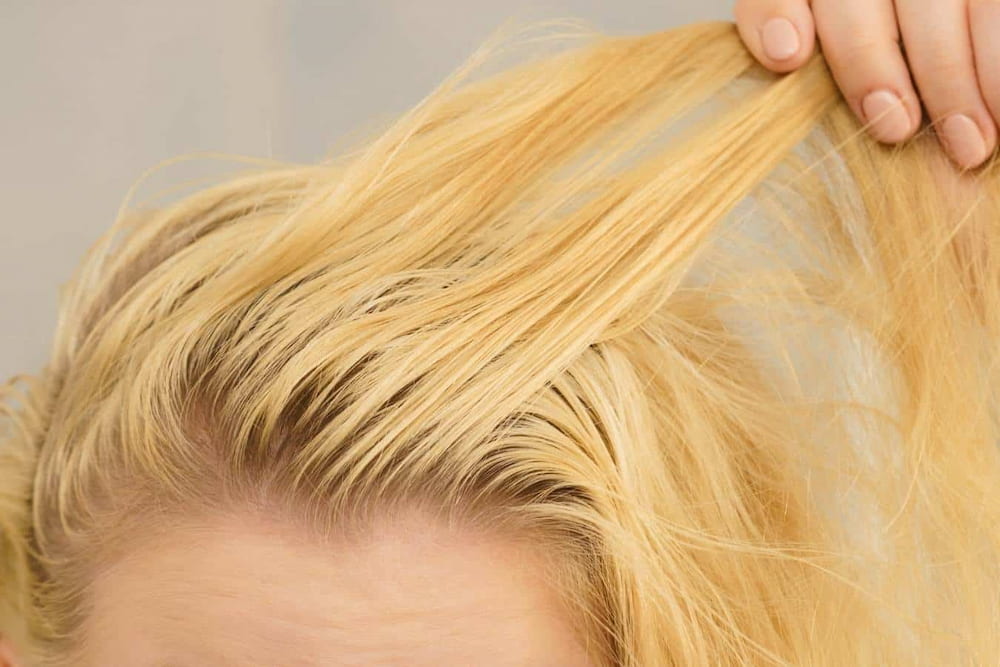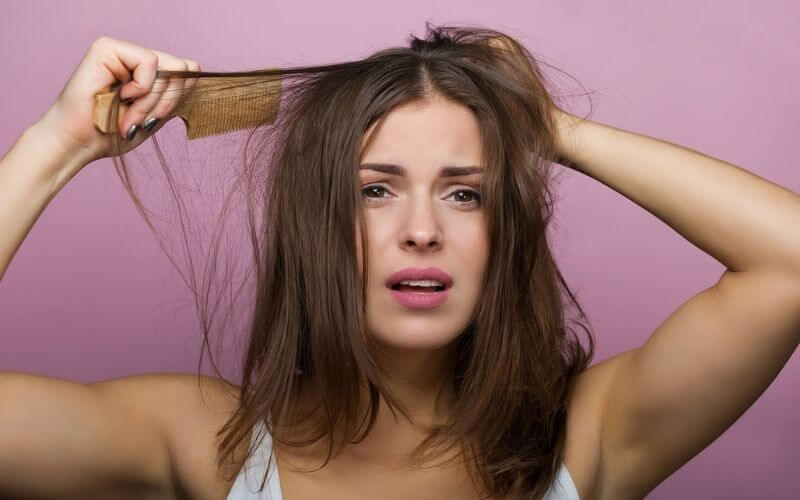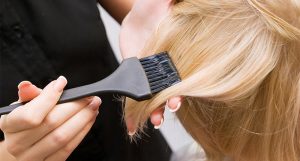
Why Does My Hair Feel Waxy After Washing? All You Want To Know
To begin with, why does my hair feel waxy after washing? The buildup is probably silicone. People who wash their hair less frequently and use styling products are typically the victims of silicone build-up. That describes pretty much all of our friends with curly hair!
Keep reading.
Table of Contents
What Is Waxy Hair?
Several factors can cause hair to become waxy. Product buildup is the most frequent cause of waxy-feeling hair. The second factor that can cause waxy hair is health problems, including stress.
Your hair may feel waxy as a result of harsh chemical treatments or specific medications. Finally, waxy hair may result from hard water. “Waxy” hair is hair that feels sticky, gunky, or greasy even after washing.
After a wash, you might notice that your hair lacks the bounce or shine you would normally expect, or you might feel grease on your fingers when touching your hair. You might experience itchy skin on your scalp and find that you need to wash your hair more frequently to make it feel clean.
Why Does My Hair Feel Waxy After Washing?
Identifying the potential cause of waxy hair is the first step in treating it. We’ll look at each one of them below. Several things could be the cause of the waxy gunk on your strands. Let’s begin immediately.
- Product buildup. On your hair, styling products can build up and leave a waxy residue. Water-resistant and adept at adhering firmly to each hair strand are product ingredients like silicones, polymers, and oils. Even after washing, this buildup can cause your hair to feel greasy, waxy, or brittle.
- Health issues. The waxy buildup on your hair may be caused by an underlying medical condition. Common causes include:
- Hormonal imbalances
- Skin conditions
- Fungal or bacterial infections
- Certain medications. Your hair may become more waxy as a result of some medications. Your body may produce too much oil if you take medications like birth control, blood thinners, and steroids. Your hair becomes stiff or waxy due to the extra oil that coats it.
- Damaged hair. Your hair’s cuticles can be damaged by heat and chemicals, which can make them look waxy or dull. If you have previously relaxed, bleached, used heat tools, or colored your hair and you notice a waxy film, it might mean that your hair is damaged.
- pollution of the environment. Your scalp may start producing more oil as a defense mechanism when it is exposed to high levels of pollution. Even your hair can become attached to some types of air pollution, which results in the formation of a waxy film.
- Hard Water. Hard water is a common problem in American homes. Minerals like calcium and magnesium that dissolve in water are present in high concentrations in hard water. These minerals can build up on your hair and leave a waxy or sticky residue behind.
- Stress.Your entire body, both inside and out, is affected by stress. Your body produces more cortisol when you are under a lot of stress. In addition, excessive cortisol can increase sebum (scalp oil) production, which can result in a waxy coating on the hair.
- Improper washing. Waxy buildup can be caused by using the incorrect cleaning products, using hot water when washing your hair, and not completely rinsing out your conditioner or shampoo. This could cause products and oils to be left behind or trigger your scalp to produce more oils.
What Does The Silicone In Hair Products Mean?
So a mineral that is actually present in the earth’s crust serves as the raw material for silicones. Silica is the name for this. If you’re trying to avoid silicones completely, then check labels for any word that ends in “cone” or “siloxane”.
Typically, they are referred to as Dimethicone, Cyclopentasiloxane, Amodimethicone, Cyclomethicone, Phenyl trimethicone, or Cyclomethicone. You get the point!

Why Is Silicone Added By Manufacturers To Hair Products?
Not toxic, keep that in mind. The cuticle of your hair is simply coated with silicones, which can’t actually penetrate your hair. People with high hair porosity, who are more likely to have frizzy hair, will find this to be especially helpful.
Silicones can:
- Temporarily soften your hair
- Make your hair appear shinier
- Protect your hair from heat styling
- Smooth your hair’s texture
- Flatten or seal split ends
- Make hair styling easier
- Make your hair easier to manage
Manufacturers intentionally add silicones to conditioners to trick consumers into believing that their hair is softer and glossier than it actually is—until it isn’t. It becomes a cycle of needing the conditioner to obtain the same “healthy hair” look, and then a few weeks later your hair feels like it won’t come clean, no matter how many times you wash it – even when removing conditioner from your hair care routine entirely! The majority of people also experience a loss of hair volume when using silicone! It’s a scary situation to be in.
Get Rid Of Waxy Build-up In Your Hair
There are three tried-and-true techniques you can use, and they’re all fairly simple.
Make Use Of A Shampoo With Surfactants.
Although we adore gentle and mild shampoos, there are times when the product buildup in our hair really just needs a little chemical help. Any unwanted oils and silicones that are hiding on the cuticle of your hair will be broken down and removed by surfactants. But remember to read the labels! When buying shampoo, make sure it contains either surfactants, sodium laureth sulfate, ammonium laureth sulfate, or cocamidopropyl betaine. Verify once more that none of the silicones mentioned above are present on the label. It would be a complete murder-suicide for your hair-restoration efforts. You can even use this shampoo sparingly, switching back to your preferred brand when you feel the need, or you can use a shampoo with disinfectants instead of your usual one.
Use A Good Silicone Build-up Is Cleared Up By Clarifying Shampoo!
Just a fancier, more potent, and more expensive shampoo, a clarifying shampoo. They contain stronger and even more surfactants than your typical shampoos, and it works. You shouldn’t use them too frequently even though they are extremely safe to use. Think of it as a complete reset of your hair for a new beginning. They are typically also available for purchase at your neighborhood salon or hairdresser. To give your hair some love and moisture back after clarifying, we advise using a really good conditioner or treatment. Keep in mind that you should be clarifying frequently if you use silicone-containing products.
Rub With A Bar Of Soap.
Many of our hairfluencers have gushed about a great hard soap scrub. It is a time-honored method for thoroughly cleaning your hair, particularly your scalp, and it also has some exfoliating advantages. It’s not intended to replace shampoo, you understand. Following a thorough shampooing, you would scrub your hair for at least two minutes with a bar of soap or lathered curd soap. Even hairfluencers have been known to gush about soap bars. If the other approaches aren’t working, you should give anything a shot. Your hair will be damaged by this, so try to deep condition after.
Wash Your Hair More Thoroughly
Make sure your hair is completely submerged in water as this is the first step in performing a proper shampoo. When your hair is completely wet, gently massage your entire scalp and crown with shampoo.
Consider shampooing your hair twice in a row if you frequently use leave-in products. The midlengths and ends of your hair should receive the most attention when you apply conditioner.
Since your scalp naturally produces oils, it doesn’t need conditioner. Most importantly, take your time and pay close attention when rinsing your hair. It’s important to ensure that you’re rinsing out all of the shampoo and conditioner.
Get A Filtered Showerhead
Installing a filtered showerhead might help if you suspect hard water is to blame for the waxy buildup on your hair.
Before the minerals that promote buildup have a chance to land on your hair, the filter will trap or neutralize them. Your skin and hair will look and feel better over time.
Try A Diy Treatment
DIY remedies can be a cost-effective and gentle solution to waxy buildup. Here are some of the more well-liked and successful remedies for waxy hair.
- Baking soda rinse. Sodium bicarbonate, a naturally clarifying substance, is the main ingredient in baking soda. To use baking soda as a hair treatment:
- Add 1 part water to 2 parts baking soda.
- Warm water should be used to thoroughly wet your hair before applying the paste in an even layer.
- After leaving the paste on for up to 30 minutes, thoroughly rinse your hair with warm water.
- As usual, shampoo and condition your hair.
- rinse with apple cider vinegar. Vinegar’s acidic composition allows it to cut through waxy buildup. Apple cider vinegar can also treat the underlying cause of your waxy buildup because it is antimicrobial and anti-inflammatory. To do an apple cider vinegar hair rinse:
- 1 part apple cider vinegar to 2 parts water is the recommended ratio.
- Apply the vinegar solution to your hair and scalp by pouring it on or using a spray bottle after shampooing.
- Before giving your hair a thorough rinse, let the mixture sit on it for up to five minutes.
- As usual, style your hair after applying your regular conditioner.
- Dish soap. Dish soap has a reputation for being able to cut through stubborn grease and waxy buildup. To give it a try:
- Work a quarter-sized amount of dish soap into a lather on wet hair.
- Once your hair has received enough lathering, rinse the soap from your hair with warm water before following up with your favorite conditioner.
- To help make up for any moisture loss, you might want to use a deep conditioner or let your regular conditioner sit for an additional 10 minutes.
Note: The natural oils in your hair can be stripped away by dish soap, which can be very drying. Do not employ this technique more than once per month and only do so if you have a hard-to-remove buildup that defies other approaches. Learn more about using dish soap in your natural hair regimen by clicking here.
Seek Medical Advice
Contacting a qualified medical professional is your best option if your waxy buildup is brought on by a medical condition, such as psoriasis or seborrheic dermatitis.
To help determine and treat the cause of your waxy buildup, speak with a dermatologist, a trichologist, or your primary care physician.
How To Prevent Waxy Hair And Silicone Build-up
Depending on your hair type and hair care routine, you can try the following tips and tricks to help prevent future build-up in your hair:
- As often as necessary, wash your hair. Depending on your hair’s needs, you can typically wash your scalp and hair once a day to once a week.
- To help detoxify, deep clean, and re-set your hair, use a clarifying shampoo as needed.
- Use as many cleanings as you can on your hairbrushes and styling equipment.
- When using a conditioner, stay away from the roots of your hair.
- Your towels, hats, beanies, pillowcases, and other items should all be thoroughly cleaned.
- Look for alternatives if necessary after checking the labels to see how many of the products you use contain silicone.
How Frequently Should You Shampoo Your Hair?
The response to this depends on the type of hair you have.
Washing thin, fine hair about two to three times a week is advised by experts. Considering how easily the oil can coat the strands, this hair type has a tendency to become waxy more quickly.
Hair that is coarse or textured can last longer because it is typically drier. A maximum of 1-2 washes are advised for this type of hair.
Outside forces, however, have an impact.
You may feel the need to wash your hair more frequently than this if you engage in frequent sweaty exercise, use a lot of styling products, or are frequently exposed to polluted environments.
Ingredients To Avoid
In your quest to avoid waxy hair, a few ingredients to avoid include:
- Coconut oil
- Sulfates
- Parabens
The battle against waxy hair can now be won, and you can enjoy beautifully clean hair.
Frequently Asked Questions
The most frequent queries regarding waxy hair are listed below.
Why Does My Hair Feel Waxy And Sticky?
There are several causes for why your hair might feel waxy or sticky. Buildup from products, particularly conditioners with silicones in them, is the most frequent cause. Another frequent cause is excessive oil production in the scalp, which is frequently brought on by seborrhea or by over-washing with sulfate-containing products.
Why Does Washing My Hair Leave It With A Waxy Feeling?
You might not be completely rinsing out your conditioner if after washing your hair it still feels sticky or waxy. It’s also possible that you’re applying too much conditioner to your hair when it’s not necessary or that you’re applying the incorrect type of conditioner for your hair.
What Is Waxy Hair?
Hair that feels waxy is hair that is greasy or stick to the touch. Waxy hair may also lack elasticity and appear limp and dull. Waxy hair may be hard to brush and may not hold a curl or style well.
How Should You Handle Waxy Hair?
The best way to treat waxy hair is to switch to a “low-poo” or “no-poo” washing routine. To avoid product buildup, only use conditioner or a low-poo shampoo when washing with a sulfate-free shampoo every other week.
Why Does Bleaching My Hair Make It Feel Waxy?
Hair that feels waxy or “gummy” after bleaching has often been over-processed to the point of being severely damaged. This kind of damage typically denotes that the hair follicle’s interior, rather than just the cuticle or outer layer, has been harmed.
Final Words
Hair that feels stiff, limp, greasy, or gooey is said to be waxy. It typically means that your hair has product buildup or has experienced damage from the environment or excessive chemical processing.
Try using sulfate-free shampoos, getting a trim, and protecting your hair from further harm as treatments for waxy hair.
Regarding your reading, I thank you.





![Native Shampoo Review Is Native Shampoo Good [2022]](https://www.musehaircare.com/wp-content/uploads/2022/11/Native-Shampoo-Review-Is-Native-Shampoo-Good-2022-300x174.jpg)
